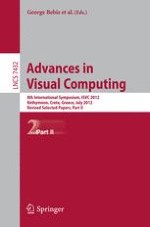The two volume set LNCS 7431 and 7432 constitutes the refereed proceedings of the 8th International Symposium on Visual Computing, ISVC 2012, held in Rethymnon, Crete, Greece, in July 2012. The 68 revised full papers and 35 poster papers presented together with 45 special track papers were carefully reviewed and selected from more than 200 submissions. The papers are organized in topical sections: Part I (LNCS 7431) comprises computational bioimaging; computer graphics; calibration and 3D vision; object recognition; illumination, modeling, and segmentation; visualization; 3D mapping, modeling and surface reconstruction; motion and tracking; optimization for vision, graphics, and medical imaging, HCI and recognition. Part II (LNCS 7432) comprises topics such as unconstrained biometrics: advances and trends; intelligent environments: algorithms and applications; applications; virtual reality; face processing and recognition.
